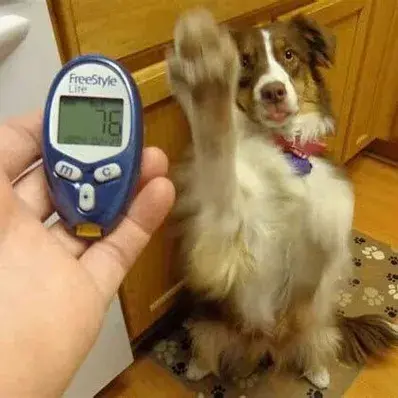What Are the First Signs of Diabetes in a Dog?
Early recognition is key to ensuring your dog maintains a good quality of life.
The early symptoms of diabetes in dogs often include:
- Increased thirst and excessive urination: One of the first signs of a blood sugar imbalance.
- Unexplained weight loss despite a normal appetite: A significant red flag tied to the inability to use glucose effectively.
- Lethargy and reduced energy: This can indicate that glucose in the blood isn’t being properly utilized for energy.
If you notice these signs, seek veterinary care promptly to begin insulin treatment if necessary. Proper treatment can significantly improve your dog’s long-term quality of life.
Advanced Symptoms and Effects of Untreated Diabetes in Dogs
As diabetes progresses, more severe symptoms may develop, including:
- Cloudy eyes or cataracts: A common complication in diabetic dogs, leading to vision problems.
- Increased appetite: Despite weight loss, your dog may feel constantly hungry due to an inability to use glucose for energy.
- Vomiting or changes in appetite: This can occur if the dog is developing diabetic ketoacidosis (DKA), a life-threatening condition.
If left untreated, diabetes can lead to serious complications, such as:
- Diabetic ketoacidosis (DKA): A potentially fatal condition where the body breaks down fat for energy, causing dangerous blood chemical imbalances.
- Kidney failure: Chronic high blood sugar can damage kidney function over time.
- Blindness: Caused by cataracts, a common issue in diabetic dogs.
- Neuropathy: Nerve damage from prolonged high blood sugar, often resulting in weakness or difficulty walking.
Timely diagnosis and treatment are essential to preventing these severe consequences and ensuring your dog remains healthy.
These diabetes signs can overlap with other conditions. It’s important to know what can be mistaken for diabetes in dogs. Examples include urinary tract infections or Cushing’s disease.
Causes of Diabetes in Dogs
Understanding what food causes diabetes in dogs and other risk factors is vital for prevention.
The primary causes of diabetes in dogs include:
- Obesity: A major risk factor linked to poor diet and high blood sugar levels over time.
- Genetics: Certain breeds like Poodles and Dachshunds are more susceptible to developing high levels of glucose in the blood.
- Hormonal Imbalances: Conditions such as pancreatitis can disrupt insulin production, leading to high blood sugar levels.
Feeding high-fat, sugary foods is a common culprit, as it can result in fluctuating blood glucose curves. Maintaining a balanced diabetes dog diet with proper nutrient control is essential for stabilizing blood sugar and reducing the risk of diabetes.
Dogs Breeds That Are Predisposed to Diabetes
Certain dog breeds are more prone to developing diabetes, including:
- Poodle
- Dachshund
- Schnauzer
- Cocker Spaniel
- Samoyed
- Australian Terrier
- Miniature Pinscher
- Labrador Retriever
- Yorkshire Terrier
- Alaskan Malamute
- Bichon Frise
These breeds have a higher risk of developing diabetes, especially if they are overweight or have a family history of the condition. Regular vet checkups and a proper diet can help manage and reduce the risk.
How to Test for Diabetes in Dogs
If you notice clinical signs of diabetes in dogs, consult your vet immediately.
The diagnosis process involves:
- Blood Glucose Tests: Elevated blood sugar levels confirm the condition.
- Urinalysis: Checks for glucose in urine.
- Fructosamine Test: Measures average blood sugar over weeks.
Accurate testing can differentiate diabetes from other illnesses like water diabetes in dogs, a rare condition related to kidney function.
How to Treat Diabetes in Dogs
Effective diabetes in dogs treatment involves a comprehensive approach to managing blood sugar levels and your dog’s overall health. Key aspects of treatment include:
Insulin Therapy
Insulin therapy is the cornerstone of diabetes management in dogs. Daily insulin injections are typically required to regulate blood sugar and prevent dangerous fluctuations.
Giving injections can feel intimidating at first, but your vet will teach you how to do it safely and keep your dog comfortable. Regular monitoring of blood glucose curves is essential to adjust the dosage and ensure effective treatment.
Dietary Management
A well-planned diabetes diet plays a crucial role in stabilizing blood glucose levels. High-fiber, low-fat diets are recommended to slow down glucose absorption and prevent sudden spikes in blood sugar.
Feeding your dog consistent portions at regular intervals helps maintain steady energy levels and avoids high levels of glucose in the bloodstream. Avoid foods high in sugar or fat, as these can exacerbate symptoms and complicate treatment.
Exercise
Regular exercise is important for maintaining a healthy weight, which helps improve insulin sensitivity. Low-impact activities such as daily walks or light play sessions are ideal. Additionally, managing conditions such as hypothyroidism is crucial, as it can lead to weight gain and complicate diabetes control. However, avoid overexertion, as this can lead to blood sugar fluctuations.
Cost Considerations
The diabetes treatment cost varies depending on your dog’s specific needs. Costs typically include insulin, syringes, routine blood sugar monitoring, specialized diets, and regular veterinary check-ups. Managing diabetes can be costly, but it improves your dog’s quality of life and prevents serious complications.
Recovery and Management of Diabetes in Dogs
Dogs with diabetes require lifelong monitoring and treatment, typically involving insulin and dietary control. After diagnosis, frequent vet visits are necessary to determine the right insulin dosage to manage blood sugar levels.
A proper puppy vaccine schedule is crucial, just like early detection and management of diabetes in dogs for their health.
Blood Glucose Curve
This method involves drawing blood every 1-2 hours to track how blood glucose levels change throughout the day. The data is plotted on a curve, helping your vet adjust insulin doses based on the highest and lowest readings.
Freestyle Libre
A small, painless sensor is placed on your dog’s skin to monitor glucose levels continuously without the need for blood draws. This method is especially helpful for anxious or uncooperative dogs, as it allows for frequent monitoring using a smartphone or reader.
Fructosamine Test
This blood test measures the average glucose levels over the past 2-3 weeks, offering a long-term view of how well the diabetes is being managed. It’s a helpful tool for chronic monitoring and assessing overall control of your dog’s blood sugar.
Urine Glucose and Ketone Tests
These are simple, at-home tests using strips to check glucose and ketone levels in your dog’s urine. While not as precise as blood tests, they provide an easy and inexpensive way to monitor blood sugar and determine if your dog’s diabetes is under control.
How Diabetes in Dogs Affects Life Expectancy
With proper care, the life expectancy of dogs with diabetes can be near-normal. However, untreated diabetes can lead to complications like ketoacidosis or cataracts. Recognizing signs that your dog with diabetes may be dying—such as severe weakness, vomiting, or difficulty breathing—signals the need for immediate veterinary attention.
Prevention: How to Prevent Diabetes in Dogs
While some cases are genetic, you can take steps to reduce your dog’s risk:
- Maintain a healthy weight through proper nutrition and exercise.
- Schedule regular veterinary check-ups.
- Avoid foods high in sugar or fat that might contribute to what food causes diabetes in dogs.
Diabetes in dogs is a manageable condition with the right care and attention. Recognizing symptoms, providing treatment, and maintaining a proper diet can help your diabetic dog live a happy life.
If you suspect diabetes, consult your vet immediately to begin the appropriate diabetes treatment.







